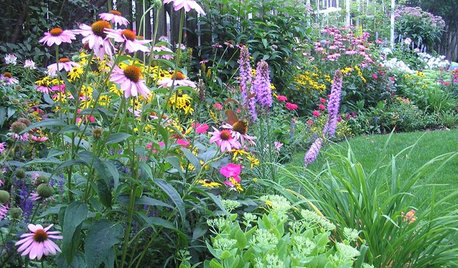Bluetranes...Bug Juice/Compost Tea/ etc.
pennymca
15 years ago
Related Stories

GARDENING GUIDESGet on a Composting Kick (Hello, Free Fertilizer!)
Quit shelling out for pricey substitutes that aren’t even as good. Here’s how to give your soil the best while lightening your trash load
Full Story
EDIBLE GARDENSGarden BFFs? Why Your Vegetables Are Begging for Companion Plants
Foster friendships among plants for protection from pests, pollination support and color camaraderie
Full Story
MOST POPULAR33 Magic Household Cleaning Tips
Houzzers from around the world share their tips for transforming housework into child’s play
Full Story
GARDENING GUIDESHow to Keep Your Citrus Trees Well Fed and Healthy
Ripe for some citrus fertilizer know-how? This mini guide will help your lemon, orange and grapefruit trees flourish
Full Story
FALL GARDENING5 Ways to Put Fall Leaves to Work in Your Garden
Improve your soil and yard the organic way with a valuable garden booster that grows on trees
Full Story
LANDSCAPE DESIGNTry Slow Gardening for Some Unexpected Benefits
Why set your garden on the fast track? Here's how to relax and enjoy it in an entirely new way
Full Story
DECORATING GUIDES15 Ways to Get Your Home in a Summer Mood
Bask in the easygoing spirit of summer with breezy touches indoors and out
Full Story
GARDENING AND LANDSCAPING10 Ways to Enjoy Your Outdoor Room More
Step up the comfiness and convenience of your porch, patio or yard to make time spent outdoors even better
Full Story
CRAFTSSimple Pleasures: Crafting for Fun and Relaxation
Recharge the unplugged way during downtime with crafts and building projects, alone or in a group
Full Story
GARDENING AND LANDSCAPINGBackyard Dreaming: 13 Ideas to Spark Your Imagination
Transform your yard or patio this spring by turning your thoughts to outdoor flights of fancy now
Full StoryMore Discussions






blutranes
pennymcaOriginal Author
Related Professionals
Kapaa Landscape Architects & Landscape Designers · Anderson Landscape Contractors · Burlington Landscape Contractors · Bethel Park Landscape Contractors · Fruit Heights Landscape Contractors · Longmont Landscape Contractors · Muttontown Landscape Contractors · Peoria Landscape Contractors · Pleasant Prairie Landscape Contractors · Shoreview Landscape Contractors · Waldorf Landscape Contractors · East Norriton Landscape Contractors · San Pablo Landscape Contractors · Greeley Decks, Patios & Outdoor Enclosures · Northbrook Decks, Patios & Outdoor Enclosuresblutranes
pkapeckopickldpepprz
greenwood85
11otis
pkapeckopickldpepprz
blutranes
pennymcaOriginal Author
pennymcaOriginal Author
blutranes
pennymcaOriginal Author
clspie
blutranes
gjcore
blutranes